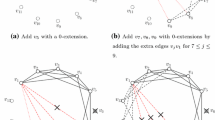Abstract
The two main concepts of Rigidity Theory are rigidity, where the framework has no continuous deformation, and global rigidity, where the given distance set determines the locations of the points up to isometry. We consider the following augmentation problem. Given a minimally rigid graph \(G=(V,E)\) in \(\mathbb {R}^2\), find a minimum cardinality edge set F such that the graph \(G'=(V,E+F)\) is globally rigid in \(\mathbb {R}^2\). We provide a min-max theorem and an \(O(|V|^2)\) time algorithm for this problem.
Access this chapter
Tax calculation will be finalised at checkout
Purchases are for personal use only
Similar content being viewed by others
References
Abbot, T.G.: Generalizations of Kempe’s universality theorem. Master’s thesis, MIT (2008). http://web.mit.edu/tabbott/www/papers/mthesis.pdf
Anderson, B.D.O., Shames, I., Mao, G., Fidan, B.: Formal theory of noisy sensor network localization. SIAM J. Discrete Math. 24, 684–698 (2010)
Aspnes, J., et al.: A theory of network localization. IEEE Trans. Mob. Comput. 5(12), 1663–1678 (2006)
Berg, A.R., Jordán, T.: Algorithms for graph rigidity and scene analysis. In: Di Battista, G., Zwick, U. (eds.) ESA 2003. LNCS, vol. 2832, pp. 78–89. Springer, Heidelberg (2003). https://doi.org/10.1007/978-3-540-39658-1_10
Connelly, R.: Generic global rigidity. Discrete Comput. Geom. 33(4), 549–563 (2005). https://doi.org/10.1007/s00454-004-1124-4
Fekete, Z., Jordán, T.: Uniquely localizable networks with few anchors. In: Nikoletseas, S.E., Rolim, J.D.P. (eds.) ALGOSENSORS 2006. LNCS, vol. 4240, pp. 176–183. Springer, Heidelberg (2006). https://doi.org/10.1007/11963271_16
García, A., Tejel, J.: Augmenting the rigidity of a graph in \({\mathbb{R}^{2}}\). Algorithmica 59(2), 145–168 (2011). https://doi.org/10.1007/s00453-009-9300-9
Gortler, S.J., Healy, A.D., Thurston, D.P.: Characterizing generic global rigidity. Am. J. Math. 132(4), 897–939 (2010)
Hopcroft, J., Tarjan, R.: Dividing a graph into triconnected components. SIAM J. Comput. 2, 135–158 (1973)
Hsu, T.S., Ramachandran, V.: A linear time algorithm for triconnectivity augmentation. In: Proceedings of the Annual Symposium on Foundations of Computer Science, pp. 548–559 (1991)
Jackson, B., Jordán, T.: Connected rigidity matroids and unique realizations of graphs. J. Comb. Theory Ser. B 94, 1–29 (2005)
Jackson, B., Jordán, T.: Graph theoretic techniques in the analysis of uniquely localizable sensor networks. In: Mao, G., Fidan, B. (eds.) Localization Algorithms and Strategies for Wireless Sensor Networks, pp. 146–173. IGI Global (2009)
Jordán, T.: On the optimal vertex-connectivity augmentation. J. Comb. Theory Ser. B 63, 8–20 (1995)
Jordán, T.: Combinatorial rigidity: graphs and matroids in the theory of rigid frameworks. In: Discrete Geometric Analysis, Volume 34 of MSJ Memoirs, pp. 33–112. Mathematical Society of Japan (2016)
Jordán, T., Mihálykó, A.: Minimum cost globally rigid subgraphs. In: Bárány, I., Katona, G.O.H., Sali, A. (eds.) Building Bridges II. BSMS, vol. 28, pp. 257–278. Springer, Heidelberg (2019). https://doi.org/10.1007/978-3-662-59204-5_8
Kaewprapha, P., Li, J., Puttarak, N.: Network localization on unit disk graphs. In: 2011 IEEE Global Telecommunications Conference - GLOBECOM 2011, pp. 1–5 (2011)
Király, Cs., Mihálykó, A.: Globally rigid augmentation of minimally rigid graphs in \({\mathbb{R}^{2}}\). Technical report TR-2020-07, Egerváry Research Group, Budapest (2020). www.cs.elte.hu/egres
Király, Cs., Mihálykó, A.: Sparse graphs and an augmentation problem. Technical report TR-2020-06, Egerváry Research Group, Budapest (2020). www.cs.elte.hu/egres. An extended abstract appeared in Bienstock, D., Zambelli, G. (eds.) Integer Programming and Combinatorial Optimization, IPCO 2020. Lecture Notes in Computer Science, vol. 12125, pp. 238–251. Springer, Cham (2020)
Laman, G.: On graphs and rigidity of plane skeletal structures. J. Eng. Math. 4, 331–340 (1970). https://doi.org/10.1007/BF01534980
Pollaczek-Geiringer, H.: Über die Gliederung ebener Fachwerke. ZAMM-J. Appl. Math. Mech. 7(1), 58–72 (1927)
Saxe, J.B.: Embeddability of weighted graphs in \(k\)-space is strongly NP-hard. Technical report, Computer Science Department, Carnegie-Mellon University, Pittsburgh, PA (1979)
So, A., Ye, Y.: Theory of semidefinite programming for sensor network localization. Math. Program. 109, 405–414 (2005). https://doi.org/10.1007/s10107-006-0040-1
Whiteley, W.: Some matroids from discrete applied geometry. In: Bonin, J.E., Oxley, J.G., Servatius, B. (eds.) Matroid Theory, Volume 197 of Contemporary Mathematics, pp. 171–311. AMS (1996)
Acknowledgements
Project no. NKFI-128673 has been implemented with the support provided from the National Research, Development and Innovation Fund of Hungary, financed under the FK_18 funding scheme. The first author was supported by the János Bolyai Research Scholarship of the Hungarian Academy of Sciences and by the ÚNKP-19-4 and ÚNKP-20-5 New National Excellence Program of the Ministry for Innovation and Technology. The second author was supported by the European Union, co-financed by the European Social Fund (EFOP-3.6.3-VEKOP-16-2017-00002). The authors are grateful to Tibor Jordán for his help, the inspiring discussions and his comments.
Author information
Authors and Affiliations
Corresponding author
Editor information
Editors and Affiliations
Rights and permissions
Copyright information
© 2021 Springer Nature Switzerland AG
About this paper
Cite this paper
Király, C., Mihálykó, A. (2021). Globally Rigid Augmentation of Minimally Rigid Graphs in \(\mathbb {R}^2\). In: Calamoneri, T., Corò, F. (eds) Algorithms and Complexity. CIAC 2021. Lecture Notes in Computer Science(), vol 12701. Springer, Cham. https://doi.org/10.1007/978-3-030-75242-2_23
Download citation
DOI: https://doi.org/10.1007/978-3-030-75242-2_23
Published:
Publisher Name: Springer, Cham
Print ISBN: 978-3-030-75241-5
Online ISBN: 978-3-030-75242-2
eBook Packages: Computer ScienceComputer Science (R0)




